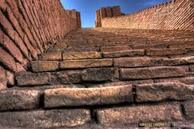
You thought I was going to say China, didn’t you?
As far as archeologists know, human beings have been building walls since Neolithic times when we transitioned from a hunting nomadic lifestyle to permanent agrarian settlements, somewhere around 10,000 BC.
Even as nomads, human beings gathered in small groups for protection, and we have evolved as social animals fundamentally wired with fear of the unknown. Behind a barrier with a place to look out and not be seen, is a safe place for humans. The development of permanent settlements resulted in the building of walls as defenses against any perceived danger that might threaten the community.
THE GREAT CITY WALLS
The development of permanent settlements resulted cities and, as they grew in size, rulers built walls as defenses against any perceived danger that might threaten the community.
The oldest walls in existence are those of Gobekli Tepe, a temple in Urfa, southeast Turkey, constructed 11,500 years ago. Around 10,000 BC the first city walls, erected for defense, were built around Jericho and the Sumerian city of Uruk. All that can be seen today are the excavation sites.
THE GREAT BORDER WALLS
Border Walls extend along part of the jurisdictional borders of the state. country, kingdom, or whatever terminology applies to an area under one ruler. These barriers appear to be a later innovation in safety and defense strategy, although the world “later” is relative. As city states or domains expanded to include other cities and territories, often the fortifications around one city were extended to another, expanding until a much larger area comprised the state or kingdom. Contemporary border walls are referred to as barriers and are constructed for other purposes.
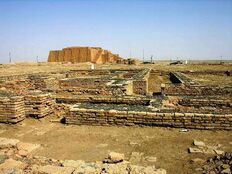
The Wall of Ur is one of the first known border walls, constructed around 2000 BC to keep out invading Amorites. It was built between the Tigris and Euphrates rivers to allow the people “to dwell peacefully in green meadows.”
It marks the beginning of the period between the third century BC to the 11th century AD referred to as the Age of the Long Wall.
Photo source: https://commons.wikimedia.org/wiki/File:Ur-Nassiriyah.jpg
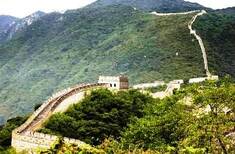
The Great Wall of China is the longest fortification in the world, but not the earliest built. In fact, it is not one continuous wall, but a series of multiple walls, trenches, towers, and forts that string along the northern portion of China for 13,170 miles. These walls were built by different emperors over many centuries, primarily to protect territory from invasion but not necessarily invasion from the foreign invaders from the north but the enemies of the particularly dynasty at the time.
The sections built by different states were unconnected until the reign of Emperor Qin Shi Huang.
| Great Wall of Qi was the first segment, started in 685 BC, to be built during the Zhou Dynasty. This barrier stretched for about 372 miles between the present-day cities of Jinan and Quingdao. The purpose was to fend off invasion from other Chinese states to the south. Wikimedia Commons, free media repository► | Photo Credit: Rolfmueller - Own work, CC BY-SA 3.0, https://commons.wikimedia.org/w/index.php?curid=4388026 |
To address harassment from the northern tribes (Tartars and Jurchens) the rulers of the Ming dynasty [1368-1644 AD] continued extension and enlargement of the wall for over two centuries. The main line of the Ming Dynasty started from Hushan in the east to the Jiayuguan Pass in the west. It has a total length of about 5,500 miles, is twenty feet wide at the bottom and sixteen feet wide at the top, and has an estimated 10,000 watch towers.
▼Photo Source: ancient-origins.net/archaeology/ancient-wall
Photo credit: aerial photography by the APAAME,
research project - settlement history in the Near East.
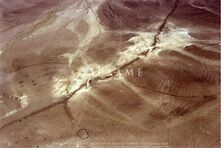
Remains of the Khatt shebib Wall, Jordan, was largely unknown, at least to outsiders, until 1948 when Sir Alec Kirkbride, a British diplomat in Jordan, spotted the ruins from an airplane. The structure extends nearly one hundred miles through the large southern desert of Jordan with nothing on either side except sand dunes.
The wall remained a mystery until recently, when the APAAME, a long-term research project, mapped it using aerial photography.
Unlike most ancient border walls, archaeologists believe this 93 mile long wall was not used for military or defense purposes. It was built by the Bedouin nomads and, based on pottery found in the ruins, certain studies have dated it to 312BC to 106 AD and reconstructions in 661-750 AD.
It was constructed with boulders piled on tops of each other with no solid foundation and nothing to hold the rocks in place. Scientists estimate its height from 31/2 feet to almost five feet, which supports the rationale that it was not a defensive wall, although they have identified over one hundred towers 61/2 by 13 feet which might serve as stations for watching for invaders.
Some experts studying the area speculate that the border wall served to restrict nomads from wandering in farming regions.
●Hadrians Wall [128 AD]
A later and much better known border wall is Hadrian's Wall in Britain, built by the Romans at the direction of Emperor Hadrian (r. 117-138 AD), to fend off incursions into the Roman provinces from across the northern border. The Romans were expert wall-builders, but it took six years to construct eighty miles across the terrain. Height and width varied, but in places it was over twenty feet high and nine feet wide, with fortified towers. The wall is now a UNESCO World Heritage site.
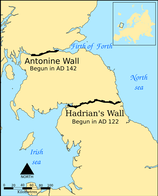
Also built by the Romans, the Antonine Wall, begun in 142 AD, stretched 39 miles between the Firth of Forth and the Firth of Clyde, in what is now Scotland. Emperor Antoninus had this barrier built to protect the region from barbarians from the north, primarily the Picts of the Scottish highlands.
The type of barrier is less like the stone walls because it is built of turf on top of a stone foundation and fronted by a deep ditch like a mote. The height was about ten feet and the width about sixteen feet, and it is believed that was a wooden palisade on top of the wall. Along its length there were 16 forts connected by roads. The turf has weathered away, making the wall almost invisible in the rolling countryside.
https://en.wikipedia.org/wiki/Antonine_Wall\
| To the far left, you can see a unique feature: a type of man-trap known as lilia. These large oval pits north of the ditch and the outer mound are the first line of defense for threats from the north. Photo sources: blog.historicenvironment.scot/antonine |
The construction took twelve years. Eight years after completion, Roman troops were pulled back to Hadrian’s Wall, and this wall was abandoned. It was refortified in 208 AD and then abandoned a second time. The parts that remain are under the care of Historic Scotland and the UNESCO World Heritage Committee.
Kerameikos (Outer) from west - the two main gates
The Dipylon and the Sacred Gate. Photo Source:
http://www.ancientathens3d.com/keramikos-tichi/
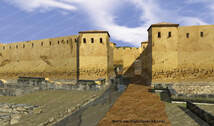
The term Long Walls is used to describe the defensive wall that connected the city of Athens with its ports at Piraeus and Phalerum. The ports were crucial to Athens, and the Long Wall was a key element of the military strategy.
The first walls, each nearly four miles in length, were constructed in phases before 431 BC, as a double wall to protect the ground access to the ports from both north and south, making Athens all but impregnable during the Peloponnesian War with Sparta and its allies.
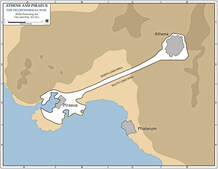
Photo source: https://en.wikipedia.org/wiki/Long_Walls (Credit: Public Domain)
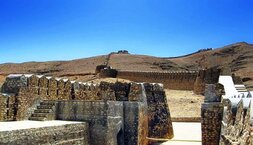
The Great Wall of Gorgan (also called the Red Snake Wall because of the color of its bricks) is a Sasanian-era (224 to 651 AD) defense system located in northeastern Iran, at the southeastern corner of the Caspian Sea. It was erected a century or two after the Roman Walls in Britain for the similar purpose of protecting the Sassanian Empire to the south from the northern peoples, probably the White Huns (the Hephthalites).
| Photo source: www.iranreview.org/The_Red_Snake_Great_Wall |
● The Great Wall of Zimbabwe
Begun in the 11th century AD, the Great Wall of Zimbabwe was erected by a Bantu-speaking ancestors of the Shona. Over the next 300 years the 36 foot high wall was expanded, enclosing approximately 1,800 acres, and is the largest ancient structure south of the Sahara Desert.
The Great Zimbabwe wall is constructed of local granite blocks split into slabs which are fitted without any mortar, one on top of the other. Each layer is a bit more recessed than those below, creating a slight inward slope for stability for the undulating walls.
| De Agostini/Getty Images / Getty Images ▲ Photo Source: https://www.tripsavvy.com/great-zimbabwe-ruins-1454657 | ▲Photo credit: evenfh—iStock/Thinkstock Photo source: https://www.britannica.com/place/Great-Zimbabwe |
Photo credit: Colin Hoskins/Imagestate -- Photo source:https://sacredsites.com/africa/zimbabwe/great_zimbabwe_ruins.html
Building walls around cities and territories is a natural thing for people to do. It’s in our DNA, so to speak. A wall is physical, something we can touch, something to rely on for protection. But do they always protect the people inside the walls?
In reading the histories of these famous walls, it became clear to me that those mighty mounds of stone, sod, and other materials did protect the residents of cities and territories from invasion time and again, but sooner or later an enemy found a way to breech them. In some cases, the invaders merely walked to the end of the wall and came around.
Costica Bradatan nails it writes. “The walls erected at borders protect people not from barbarians, but from anxieties and fears. Walls, then, are built not for security, but for a sense of security. The distinction is important, as those who commission them know very well. What a wall satisfies is not so much a material need as a mental one … In this way, they are built not for those who live outside them, threatening as they may be, but for those who dwell within. In a certain sense, then, what is built is not a wall, but a state of mind.”
https://opinionator.blogs.nytimes.com/2011/11/27/scaling-the-wall-in-the-head/
Another aspect of human nature that became clear was human curiosity. As soon as we are behind our walls, safe and secure, we want to go outside, cross the river, and get to the other side to find out what’s happening out there.
Is it possible we build walls, almost as a dare, so others will tear them down?
□
Sources:
https://opinionator.blogs.nytimes.com/2011/11/27/scaling-the-wall-in-the-head/
https://bigthink.com/philip-perry/3-border-walls-from-history-and-what-they-tell-us-about-trumps-proposal
https://ips-dc.org/the-psychology-of-the-wall/
https://www.wikiwand.com/en/Great_Zimbabwe
http://www.greatzimbabweruins.com/
https://www.pinterest.com/pin/188025353164802587/?lp=true
https://www.metmuseum.org/toah/hd/zimb/hd_zimb.htm
https://sacredsites.com/africa/zimbabwe/great_zimbabwe_ruins.html
https://www.ancient-code.com/the-great-ziggurat-of-ur-an-ancient-temple-honoring-the-anunnaki/
http://www.iranreview.org/content/Documents/The_Red_Snake_The_Great_Wall_of_Gorgan.htm
https://www.ancient.eu/Sacsayhuaman/
https://en.wikipedia.org/wiki/Fall_of_Constantinople
https://www.ancient.eu/image/9254/the-inner-walls-of-babylon/
https://en.wikipedia.org/wiki/Walls_of_Ston
https://www.jewishvirtuallibrary.org/history-and-overivew-of-the-western-wall
https://www.britannica.com/topic/Western-Wall
https://www.ancient.eu
https://www.inrap.fr/en/periods
https://en.wikipedia.org/wiki/Babylon
http://www.theottomans.org/english/campaigns_army/1453-the-conquest.asp
https://www.dailysabah.com/feature/2015/07/31/the-historical-city-gates-of-istanbul
http://www.tourmakerturkey.com/old-city-walls.html
https://www.globalsecurity.org/military/world/iraq/babylon-walls.htm
https://www.historyextra.com/period/ancient-history/border-walls-history-mexico-trump-china-great-wall/
https://www.travelchinaguide.com/china_great_wall/history/
https://en.wikipedia.org/wiki/Sasanian_Empire
https://brewminate.com/the-long-walls-of-ancient-athens/
https://www.ancient-code.com/the-great-ziggurat-of-ur-an-ancient-temple-honoring-the-anunnaki/
https://www.historyextra.com/period/ancient-history/border-walls-history-mexico-trump-china-great-wall/
https://www.history.com/news/7-famous-border-walls
https://themysteriousworld.com/top-10-amazing-ancient-walls-around-world/
http://www.emersonkent.com/map_archive/athens_piraeus_431_bc.htm
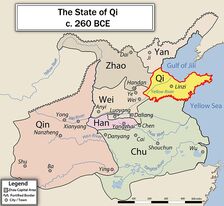
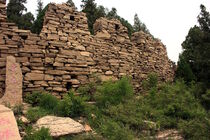
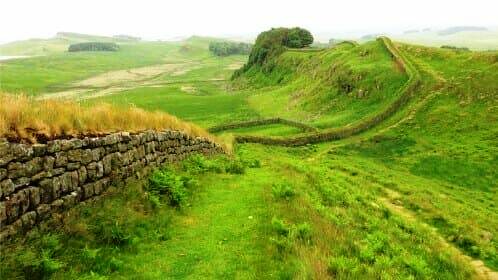
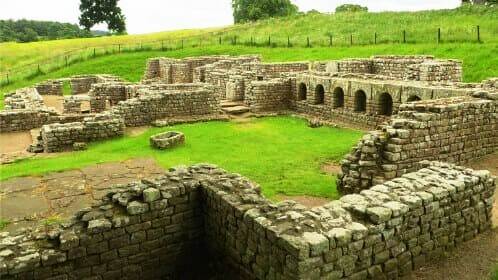
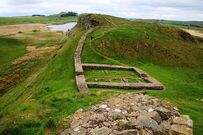
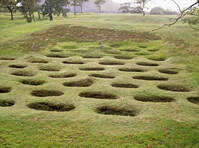
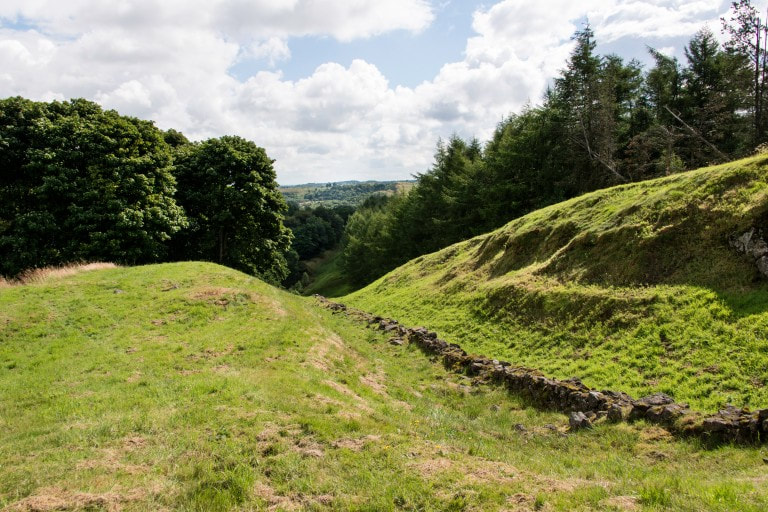
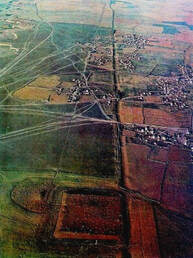
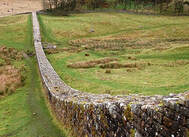
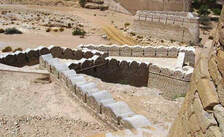
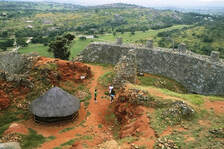
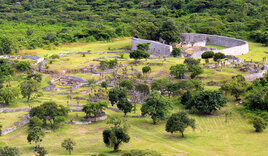
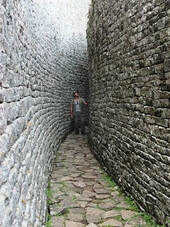
 RSS Feed
RSS Feed